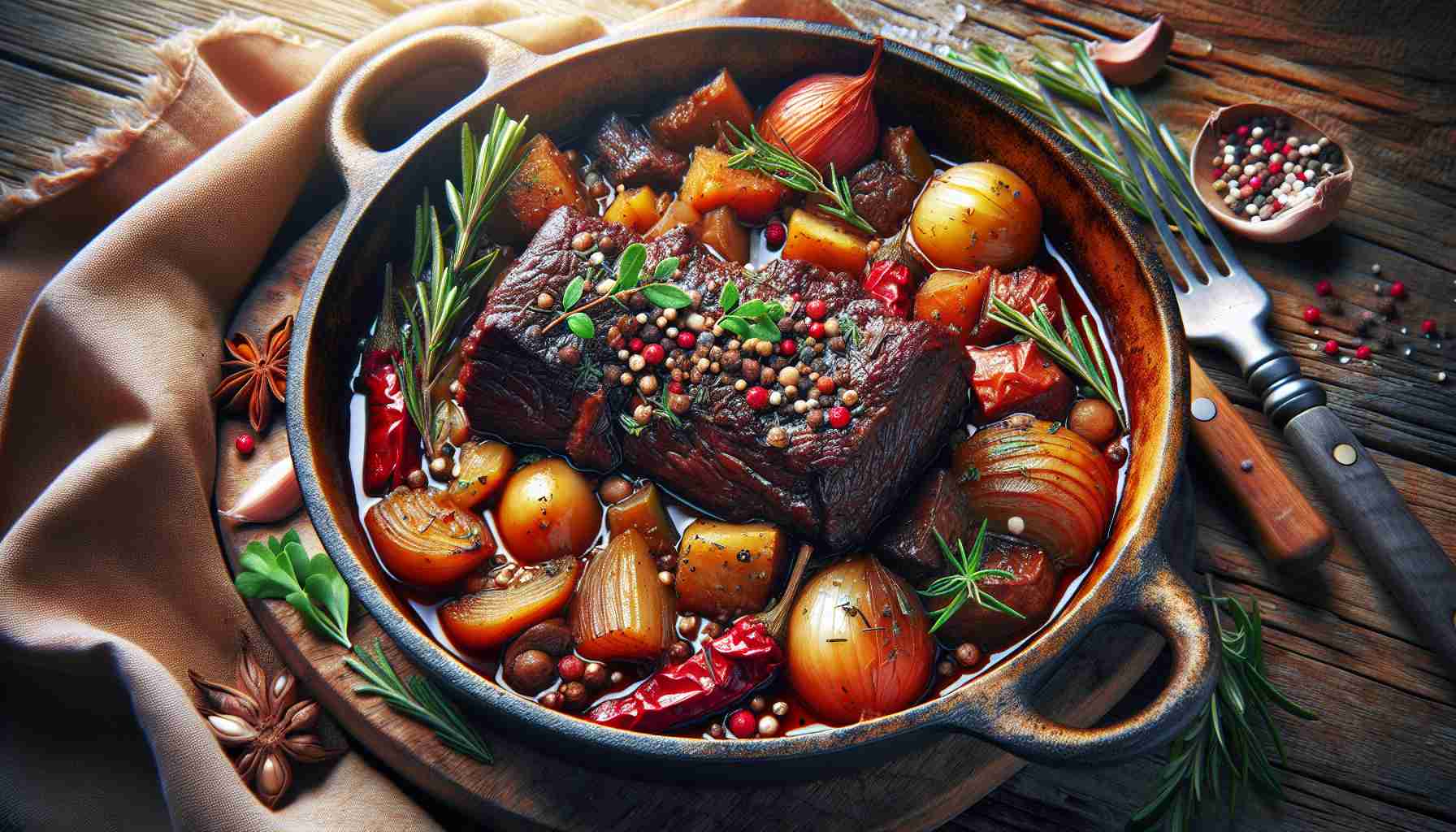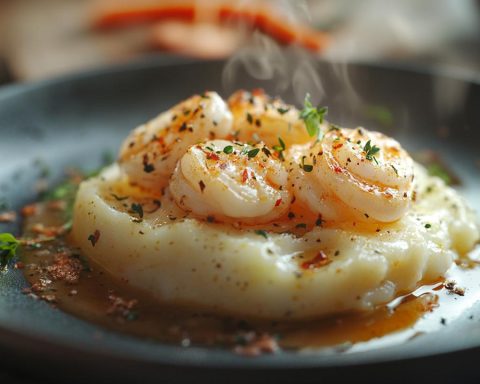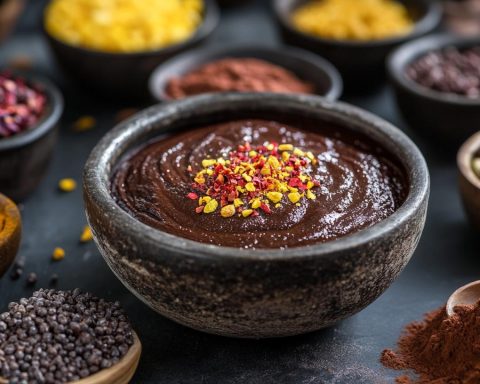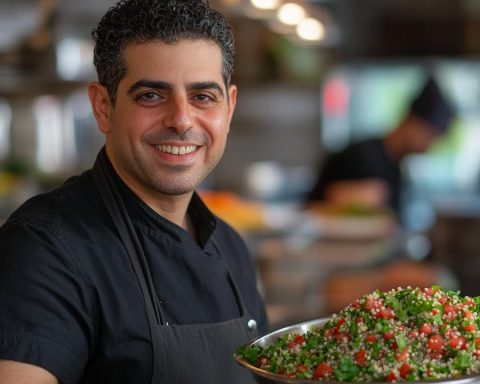The whisper of the mistral winds weaving through olive groves, the intoxicating scent of lavender fields, and the sun-drenched vibrancy of the southern French countryside all converge beautifully in a single dish: the Beef Daube. This heartwarming stew, hailing from the rustic kitchens of Provence, is a testament to the region’s affinity for bold, yet comforting flavors. Daube is traditionally prepared in a daubière, a special crockpot, but it’s just as delightful cooked in any heavy, lidded casserole. Perfect for robust seasonal gatherings or leisurely Sunday lunches, its slow-cooked magic transforms humble ingredients into a lavish, soul-satisfying feast. Rich aromatics and red wine form the foundation, enveloping tender cubes of beef that melt in your mouth, punctuated by the occasional sweetness of carrots and zest of orange peel. This is a dish best savored slowly, preferably shared with loved ones over good conversation and a glass of fine red wine.
Ingredients:
– 2 lbs (900g) beef chuck roast, cut into 2-inch cubes
– 1 bottle (750ml) full-bodied red wine (preferably Côtes du Rhône or similar)
– 2 tablespoons olive oil
– 2 large onions, thinly sliced
– 3 cloves garlic, finely chopped
– 4 carrots, peeled and cut into thick slices
– 1 celery stalk, finely chopped
– 1 large orange, zested in wide strips
– 2 bay leaves
– 1 teaspoon dried thyme
– 1 tablespoon tomato paste
– 2 tablespoons flour
– 1 cup (240ml) beef stock
– Salt and pepper to taste
– Fresh parsley, finely chopped for garnish
Instructions:
1. Marinate the beef: In a large bowl, combine the beef cubes with the red wine, half of the garlic, orange zest strips, and bay leaves. Cover and refrigerate for at least 4 hours, preferably overnight, to allow the flavors to meld and tenderize the meat.
2. Brown the beef: Preheat your oven to 325°F (165°C). Use a slotted spoon to remove the beef from the marinade, patting the pieces dry with paper towels. Reserve the marinade for later use. In a large, heavy-bottomed casserole or Dutch oven, heat olive oil over medium-high heat. Brown the beef in batches, ensuring not to overcrowd the pan. Transfer the browned beef to a plate and set aside.
3. Sauté the aromatics: Lower the heat to medium and add the onions, carrots, and celery to the remaining oil in the pot. Sauté for about 5-7 minutes, or until the onions are translucent and the vegetables begin to soften. Stir in the remaining garlic and thyme, cooking for another minute until fragrant.
4. Build the stew’s base: Stir in the tomato paste and flour, coating the vegetables thoroughly. Gradually pour in the reserved marinade and beef stock, scraping up any browned bits from the bottom of the pot with a wooden spoon. Bring the mixture to a simmer.
5. Long, slow braise: Return the beef to the pot, along with any juices it released. Add salt and pepper to taste, then cover the pot with a tight-fitting lid. Transfer to the preheated oven and let it gently braise for 3-4 hours, or until the beef is exceptionally tender, and the sauce has thickened and reduced.
6. Finishing touch: Once cooked, remove the bay leaves and orange zest. Adjust seasoning with additional salt and pepper if necessary. Garnish with freshly chopped parsley before serving.
Cooking Tips:
– For an added depth of flavor, try adding a handful of pitted olives or a few chopped anchovy fillets during the last hour of cooking.
– If you don’t have a suitable casserole pot with a lid, simply create a tight seal with aluminum foil before placing it into the oven.
Serving Suggestions:
Beef Daube pairs delightfully with creamy mashed potatoes, buttered noodles, or even a crusty baguette to mop up the luscious sauce. Serve alongside a fresh green salad and, of course, a glass of the same red wine used in the marinade to enhance the experience of its layered flavors even further. Enjoy the harmonious blend of history, tradition, and taste that this Provençal classic brings to your table.
Is Beef Daube the Best-kept Secret of French Cuisine?
While the heartwarming story of Beef Daube encapsulates the essence of Provence’s rustic kitchens, there are intriguing facets and controversies surrounding this classic dish that often go unnoticed. Here are some lesser-known facts and topics of debate about beef daube that can bring new flavors to your kitchen.
A Dash of History: The origins of Beef Daube can be traced back to ancient Roman times when marinating meat in wine was a common practice to tenderize tougher cuts. This technique evolved into the sumptuous dish we savor today, serving as a delicious bridge from past to present.
A Touch of Controversy: The selection of wine is a talking point among culinary enthusiasts. Purists insist on using wines from the Côtes du Rhône for authenticity, while others argue that any full-bodied red wine will suffice, opening up a world of possibilities from different wine regions. Whichever side you lean toward, remember: the wine is as crucial as any other ingredient.
Unexpected Twists: Have you ever considered adding chocolate to your Beef Daube? Some chefs recommend a small piece of dark chocolate for a unique depth and richness. While unconventional, this secret ingredient could transform your stew into a culinary masterpiece, intriguing both chefs and foodies alike.
Can You Master the Art at Home? Absolutely. With patience and the right ingredients, Beef Daube is a dish anyone can master. Each step of its preparation is an invitation to slow down and savor each moment, much like the dish itself.
For more insights on French cuisine, visit BBC Good Food or Bon Appétit.








